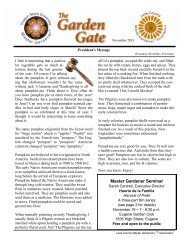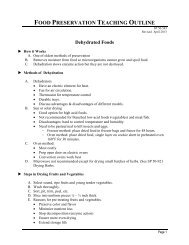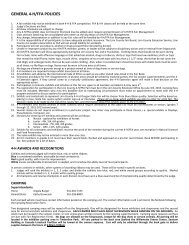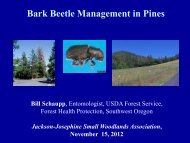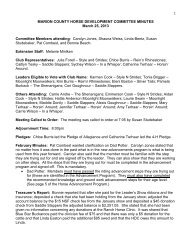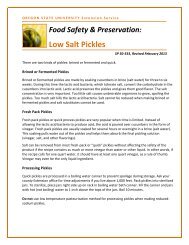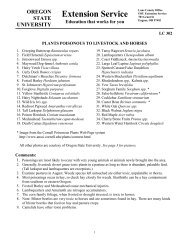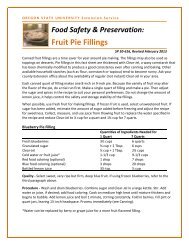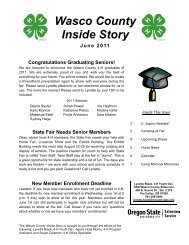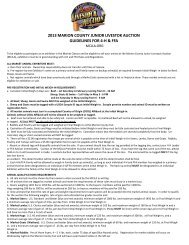Farm Planning and Enterprise Selection - Oregon State University ...
Farm Planning and Enterprise Selection - Oregon State University ...
Farm Planning and Enterprise Selection - Oregon State University ...
Create successful ePaper yourself
Turn your PDF publications into a flip-book with our unique Google optimized e-Paper software.
<strong>Farm</strong> <strong>Planning</strong> <strong>and</strong><br />
<strong>Enterprise</strong> <strong>Selection</strong><br />
Exploring the Small <strong>Farm</strong> Dream<br />
Thank you to the New Engl<strong>and</strong> Small <strong>Farm</strong> Institute <strong>and</strong> Cornell<br />
<strong>University</strong> for materials <strong>and</strong> information related to small farm<br />
planning.
What is a Small <strong>Farm</strong>?<br />
►A A small, family farm is a farm with gross<br />
sales less than $250,000.*<br />
►Limited-resource farms<br />
►Retirement <strong>Farm</strong>s<br />
►Lifestyle Lifestyle <strong>Farm</strong>s<br />
►<strong>Farm</strong>ing-occupation farms –<br />
Low-sales farms<br />
Medium-sales farms<br />
*USDA Department of Agriculture, National Commission on Small <strong>Farm</strong>s, 1998
U.S. Small <strong>Farm</strong> Statistics<br />
►Small, Small, family farms make up 91% of all U.S.<br />
farms.<br />
►Small Small farms account for most farm assets<br />
including 70% of the l<strong>and</strong> owned by farms.<br />
►Small Small farms account for 82% of the l<strong>and</strong><br />
enrolled in the Conservation Reserve<br />
Program <strong>and</strong> Wetl<strong>and</strong>s Reserve Program.<br />
►But, But, large-scale family farms account for<br />
59% of the value of production, while small<br />
farms account for only 27%.
Jackson County Small <strong>Farm</strong>s<br />
►1,953 1,953 farms.<br />
►Average Average size of farms is 129 acres.<br />
►70% 70% of the farms are under 50 acres.<br />
►97% 97% of the farms made less than $100,000.<br />
►Average market value of production for a<br />
farm was $27,748 in 2002.<br />
►26.87% of farms in cropl<strong>and</strong>, 37.52% of<br />
farms in pasture, the rest is in woodl<strong>and</strong><br />
<strong>and</strong> other uses.
The Importance of Small <strong>Farm</strong>s<br />
► Increase the biological diversity of l<strong>and</strong>scapes.<br />
► L<strong>and</strong> in financially successful small farms may be<br />
preserved from urban <strong>and</strong>/or industrial farming<br />
uses.<br />
► Provide varying levels of rural income <strong>and</strong><br />
economic opportunity for rural communities.<br />
► Enhance access to fresh foods for urban areas<br />
where food security is a problem.<br />
► Part of the cultural heritage of rural communities.
Describe Your Small <strong>Farm</strong> Dream<br />
Van Gogh, Wheat Field with Rising Sun<br />
►Why Why do you want to farm?
Whole <strong>Farm</strong> <strong>Planning</strong><br />
►Ties Ties all elements of a farm plan together—<br />
environmental, economic <strong>and</strong> social—into<br />
into<br />
an integrated whole.<br />
►Provides Provides a road map for the future.<br />
►Helps Helps to plan for future profitability.<br />
►Prepares Prepares you for expansion <strong>and</strong> change.<br />
►Helps Helps you consider environmental quality,<br />
personal goals <strong>and</strong> economics.<br />
►Provides Provides you with a nice reference<br />
document.
Whole <strong>Farm</strong> <strong>Planning</strong>
Setting Goals<br />
1. Quality of life for you <strong>and</strong> your family.<br />
2. Your vision for the future of your farm.<br />
3. How your farm enterprise will provide the<br />
income <strong>and</strong> living environment you need.<br />
► Develop long-term <strong>and</strong> short-term term goals that correspond to<br />
the social, environmental <strong>and</strong> economic resources of your<br />
farm.<br />
► Set goals with everyone involved with the farm.
Quality of Life Considerations<br />
►What What is it you want from your life?<br />
►How How can you make farming enjoyable <strong>and</strong><br />
rewarding for the whole family?<br />
►What What would you like for your children <strong>and</strong><br />
for your community?<br />
►In laying out your quality of life goals, think<br />
about your health, happiness, , <strong>and</strong><br />
cultural needs as well as your time <strong>and</strong><br />
spiritual values.
Vision for future of your farm<br />
► What do you expect to produce from your l<strong>and</strong>?<br />
► Do you want to produce your own food, or do you<br />
want profits from crops <strong>and</strong> livestock?<br />
► What stewardship practices are important to you?<br />
► What do you want your farm to look like in the<br />
future?<br />
► What key elements should be<br />
included in your vision of the<br />
farm, i.e. water quality, wildlife<br />
preservation, etc.?
Financial Considerations & Goals<br />
►Will Will this provide the full income for your<br />
family, or will it be supplemental to another<br />
job?<br />
►How How long can you wait before your<br />
agricultural enterprise generates income?<br />
►What What kind of money can you invest up<br />
front?<br />
►What What financial obligations do you have, or is<br />
your goal to reduce debt?
Examples of Goals<br />
►I I want to improve the soil conditions on my<br />
farm.<br />
►I I want to put my farm into a conservation<br />
easement <strong>and</strong> leave it to my family for<br />
farm-use.<br />
►I I want the flexibility of working at<br />
home <strong>and</strong> for myself with my<br />
family on the l<strong>and</strong>.<br />
►I I want to develop a more profitable<br />
marketing strategy.
Assessing Your Resources<br />
►Evaluate Evaluate your physical, financial <strong>and</strong> labor<br />
resources to choose an appropriate<br />
enterprise.<br />
►Even Even if you already have<br />
an enterprise idea, do<br />
your farm inventory<br />
anyway—it will show the<br />
suitability of your<br />
enterprise <strong>and</strong> maybe,<br />
bring up new ideas.
Start With a <strong>Farm</strong> Map<br />
►Creating Creating a visual map of your farm will help<br />
you underst<strong>and</strong> your resources, enterprise<br />
options <strong>and</strong> l<strong>and</strong> limitations.<br />
►Use Use aerial maps of your farm to map out<br />
your farm plan.<br />
►Or, Or, draw your farm <strong>and</strong> add-in all stationary<br />
buildings, wells, etc.<br />
►Using Using your farm map to draw out various<br />
fields or paddocks will help you plan for<br />
future costs <strong>and</strong> long-term design.
Resources to Evaluate<br />
►CapitalCapital<br />
►SkillsSkills<br />
►LaborLabor<br />
►L<strong>and</strong>L<strong>and</strong><br />
►SoilsSoils<br />
►WaterWater<br />
►ClimateClimate<br />
►Equipment<br />
►Marketing
L<strong>and</strong><br />
►What What size is your farm?<br />
►How How much l<strong>and</strong> is in timber, woodlot,<br />
pastures or brush?<br />
►The The condition of your l<strong>and</strong>, soil type <strong>and</strong><br />
climate are the main factors in determining<br />
what you can do on your farm.
Classifying L<strong>and</strong><br />
►Eight Eight capability classes defining usage <strong>and</strong><br />
treatment of l<strong>and</strong>.<br />
►Classes Classes are based on slope of l<strong>and</strong>, available<br />
water capacity <strong>and</strong> soil drainage.<br />
►Generally, class 1 – 4 are suitable for<br />
cultivation <strong>and</strong> classes 5 – 8 are suitable for<br />
pasture, woodl<strong>and</strong> or wildlife.<br />
►With With proper management <strong>and</strong> conservation<br />
practices, l<strong>and</strong>s may be used for cultivation<br />
that are not classified as such.
Soils<br />
►What is your soil type <strong>and</strong><br />
fertility?<br />
►There There are more than 18,000<br />
soils in the U.S.<br />
►Each Each type of soil varies in<br />
shallowness <strong>and</strong> depth, clay<br />
to s<strong>and</strong> to loam <strong>and</strong> well-<br />
drained or wet.<br />
►Each Each type of soil is suitable for<br />
different crops <strong>and</strong> livestock.
Two types of soils: 158B, Ruch gravelly silt loam, 2 to 7<br />
percent slopes & 108D: Manita loam, 7 to 20 percent<br />
slopes
Know Your L<strong>and</strong><br />
►Find Find out your soil classifications,<br />
series, properties <strong>and</strong> usage online.<br />
►Get Get your soil tested for fertility,<br />
<strong>and</strong> any contaminants as well.<br />
►Natural Natural Resource Conservation<br />
Service--<br />
--Online Soil Surveys for<br />
Jackson County<br />
http://websoilsurvey.nrcs.usda.<br />
gov/app/
Water<br />
►What What kind of water do you have on your<br />
farm?<br />
►Where Where does the water come from? Does it<br />
start on your farm?<br />
►Do you have water rights on your farm?<br />
►What What can you irrigate from –<br />
a creek, river, irrigation<br />
ditch, pond or well?<br />
►Is your water source<br />
unpolluted?
Water<br />
► Find out the water needs for the various<br />
enterprises you are interested in undertaking.<br />
► Know the flow <strong>and</strong> quantity of water from your<br />
wells.<br />
► Have your water tested for mineral content <strong>and</strong><br />
pollution.<br />
► Visit with the Jackson County Watermaster to<br />
review your water rights.<br />
http://www.co.jackson.or.us, , or (541) 774-6880
Climate<br />
► Temperatures <strong>and</strong> frost zones are important to<br />
consider when deciding what to farm.<br />
► Sun exposure, rainfall, air movement <strong>and</strong> frost are<br />
very important factors to consider in a successful<br />
small farming venture.<br />
► Some crops need a minimum of heat units over<br />
time to mature, i.e. tomatoes.<br />
► You can create microclimates on your<br />
farm with windbreaks, trees,<br />
greenhouses <strong>and</strong> high tunnels, buildings<br />
<strong>and</strong> natural depressions in the l<strong>and</strong>.
Climate<br />
► For descriptions of last frost dates, annual<br />
precipitation, average growing season numbers,<br />
<strong>and</strong> average temperatures, go to the OSU climate<br />
page for Jackson <strong>and</strong> Josephine Counties at<br />
http://www.ocs.oregonstate.edu/index.html<br />
www.ocs.oregonstate.edu/index.html.<br />
►<br />
For example, in Medford<br />
Climate Zone 3<br />
Last frost date - ~May 15 th (give or take a few weeks)<br />
First frost date - ~October 15 th (give or take a few weeks)<br />
Mean Annual Precipitation – 18.37”<br />
75% of rain falls between November - March<br />
Mean Annual Temperature – 54.5 degrees<br />
Average growing season is between 140 – 200 days, depending on<br />
elevation.
Equipment<br />
► What are the equipment needs for your enterprise?<br />
► Tractors, tractor implements, high-quality h<strong>and</strong><br />
tools, fencing <strong>and</strong> other equipment can be an<br />
expensive investment. Do your research <strong>and</strong> know<br />
what you need for production <strong>and</strong> efficiency.<br />
► Capitalize on free<br />
energy resources to do<br />
the work for you, i.e.<br />
sun, wind, livestock.<br />
Be creative!
Capital<br />
►How How much are you willing to risk on the<br />
enterprise?<br />
►Do you have savings, or are you willing to<br />
borrow money for the investment?<br />
►Do your neighbors or others have<br />
equipment you can rent?<br />
►Can Can you buy old equipment <strong>and</strong> refurbish?<br />
►How How long can you wait before you<br />
get a return on your investment?
Skills<br />
►What What do you love to do?<br />
►What What do you know how to do?<br />
►Learn Learn how to manage your enterprise by<br />
farming with someone else, at trainings <strong>and</strong><br />
classes or through trial-<strong>and</strong><br />
<strong>and</strong>-error.<br />
►What What do you do well?<br />
►How How much time do you want to<br />
spend farming <strong>and</strong> marketing?
What skills do you need?<br />
► Vegetables – crop <strong>and</strong> soil knowledge, planting,<br />
field prep, harvesting, weather/season, pest <strong>and</strong><br />
weed control, irrigation, marketing.<br />
► Vine & Bramble – soil <strong>and</strong> planting knowledge,<br />
propagation, trellising, cultivation <strong>and</strong> harvesting,<br />
adding value, irrigation, winter prep, etc.<br />
► Sheep – Breed knowledge, flushing, tagging,<br />
delivery of lambs, shearing, h<strong>and</strong>ling/moving<br />
sheep, behavioral knowledge, shelter <strong>and</strong> feeding<br />
needs, fencing <strong>and</strong> marketing.
Labor<br />
► Will it be just you working, or will you have a<br />
combination of family working on the farm?<br />
► How much labor does your enterprise require <strong>and</strong><br />
do you have the time available to meet the crop or<br />
animal’s s labor needs?<br />
► Think about timing <strong>and</strong> season, also<br />
when thinking about labor.<br />
► If a family enterprise, think about what<br />
each person is good at <strong>and</strong> divide labor<br />
that way.
Labor<br />
► <strong>Farm</strong> labor is generally measured by the number<br />
of 10-hour work days required under average<br />
conditions to take care of a certain number of<br />
acres, or so many head of livestock.*<br />
► Six 10-hour days per week for 50 weeks allows for<br />
3,000 hours of labor available for one full-time<br />
farmer.<br />
► Think about seasonal labor costs if your<br />
production outgrows your family.<br />
► Don’t t forget to budget in leisure time with family<br />
to keep the quality of life st<strong>and</strong>ard very high.<br />
*Making Your Small <strong>Farm</strong> Profitable – Ron Macher, 1999
Marketing<br />
►Who Who will you sell to? How much <strong>and</strong><br />
at what price?<br />
►Excellent Excellent marketing skills are necessary for<br />
a new enterprise.<br />
►Do market research <strong>and</strong> design a marketing<br />
plan.<br />
►Find Find a niche.
Create an Action Plan<br />
►Evaluate Evaluate your inventory <strong>and</strong> goals to<br />
identify potential enterprises or<br />
management alternatives that work for you.<br />
►What What do you need to in the next six to<br />
twelve months to meet some of your short-<br />
term goals?<br />
►Always Always return to your goals <strong>and</strong> vision when<br />
designing your action plan.
Monitor Your Success<br />
►As you go along, evaluate how the plan is<br />
working <strong>and</strong> refine as necessary.<br />
►Keep Keep good records <strong>and</strong> check-in with your<br />
progress to see how you are reaching your<br />
goals.<br />
►Goals Goals may need revising over<br />
time.
Diversification to Enhance Your<br />
<strong>Farm</strong> & Profits<br />
►Diversifying spreads your economic risk.<br />
►Exploits Exploits profitable niche<br />
markets.<br />
►Creates Creates new agricultural<br />
industries.<br />
►Aids Aids the local economy by allowing<br />
producers to grow crops that would<br />
otherwise be imported.
Enhancing Profits<br />
► Strategic diversification improves your overall<br />
economic picture.<br />
► Choosing an alternative crop may bring you higher<br />
gross income with production costs dropping.<br />
► Reduces economic risk associated with weather or<br />
pest damage in any one farm crop situation.<br />
► As markets exp<strong>and</strong> for diverse<br />
products, there is more opportunity<br />
for product development.
Ecology & Community<br />
►<strong>Farm</strong> <strong>Farm</strong> ecosystem diversity = stability in the<br />
farm environment.<br />
►Direct Direct marketing of diverse <strong>and</strong> alternative<br />
crops creates new opportunities for<br />
processing, packaging <strong>and</strong> new products.
<strong>Enterprise</strong> Budgets<br />
►They They are useful planning tools to help you<br />
determine the most profitable enterprise.<br />
►Can Can also assist with<br />
developing your<br />
markets <strong>and</strong> clarifying<br />
your action plan.<br />
►You You can develop your own or start with one<br />
that has already been developed.
<strong>Enterprise</strong> Budgets<br />
►Generally Generally split out into variable operating<br />
costs, fixed costs <strong>and</strong> expected production<br />
returns.<br />
►They They can be simple or complex, but should<br />
give you a clear idea whether you can<br />
break-even, even, make a profit or lose money.
New <strong>Farm</strong>er Resources<br />
►<strong>Oregon</strong> <strong>Oregon</strong> Small <strong>Farm</strong>s<br />
http://oregonstate.smallfarms.edu<br />
►Growing Growing New <strong>Farm</strong>ers<br />
www.growingnewfarmers.org<br />
►Washington Small <strong>Farm</strong>s<br />
http://smallfarms.wsu.edu<br />
►Center Center for Integrated Agricultural Systems<br />
http://www.cias.wisc.edu<br />
www.cias.wisc.edu/
Business <strong>Planning</strong> Resources<br />
► <strong>Oregon</strong> Small Business Development Center<br />
http://www.bizcenter.org/<br />
► BizPlanIt<br />
http://www.bizplanit.com/vplan.html<br />
► U.S. Small Business Administration<br />
http://www.sba.gov/starting_business/planning/basi<br />
c.html<br />
► The Deming Center Business <strong>Planning</strong> Center<br />
http://leeds-faculty.colorado.edu/moyes/bplan<br />
faculty.colorado.edu/moyes/bplan/
<strong>Enterprise</strong> Budget Links<br />
► <strong>Oregon</strong> <strong>State</strong> Univ. Agricultural <strong>Enterprise</strong> Budgets<br />
http://oregonstate.edu/dept/EconInfo/ent_budget<br />
► Agricultural Alternatives<br />
http://agalternatives.aers.psu.edu/Default.asp<br />
► UC Davis Cost & Return Studies<br />
http://www.agecon.ucdavis.edu/outreach/cost_an<br />
d_return.php<br />
► UC Vegetable Research & Information Center<br />
http://vric.ucdavis.edu/veginfo/topics/prodcosts/or<br />
ganiccostsreport.htm
Other Resources<br />
► <strong>Oregon</strong> <strong>State</strong> <strong>University</strong> Extension Service<br />
http://extension.oregonstate.edu/<br />
► Appropriate Technology Transfer for Rural Areas<br />
www.attra.org<br />
► National Agricultural Library Rural Information Center<br />
http://www.nal.usda.gov/ric<br />
www.nal.usda.gov/ric/<br />
► Sustainable Agriculture Research <strong>and</strong> Education<br />
www.sare.org<br />
► Alternative <strong>Farm</strong>ing Systems Information Center<br />
http://www.nal.usda.gov/afsic<br />
www.nal.usda.gov/afsic/<br />
► Organic <strong>Farm</strong>ing Research Foundation<br />
www.ofrf.org




